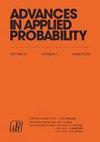离散截尾δ-冲击模型中随机变量的分布
IF 1.2
4区 数学
Q3 STATISTICS & PROBABILITY
引用次数: 0
摘要
假设一个系统受到一系列随机冲击的影响,这些冲击在一定时期内发生。本文研究了离散截尾$\delta$ -冲击模型$\delta \ge 1$,该模型假定连续冲击之间的到达时间由一阶马尔可夫链描述(以及在二项冲击过程下,即连续冲击之间的到达时间具有几何分布),当从最后一次冲击到$\delta$ -长度的时间段内没有发生冲击时,系统失效。利用Chadjiconstantinidis等人引入的马尔可夫链嵌入技术。prop .32, 2000),我们研究了系统寿命、冲击次数和无冲击发生的周期数的联合分布和边际分布,直至系统失效。得到了这些随机变量的联合概率和边际概率生成函数,并给出了它们的概率质量函数和矩的几个递推式和精确公式。证明了系统的寿命服从阶为$\delta$的马尔可夫几何分布(二项设置下阶为$\delta$的几何分布),并服从矩阵几何分布。通过证明系统寿命随机变量的位移服从复合几何分布,给出了系统在二项冲击过程下的一些可靠性特性。最后,我们引入了一种新的混合离散截尾$\delta$ -冲击模型,当最后一次冲击在$\delta$ -长度的时间内没有发生冲击,或者冲击的幅度大于给定的临界阈值$\gamma >0$时,系统就会失效。同样地,对于该混合模型,我们研究了在二项冲击过程下,系统的寿命、冲击次数和不发生冲击的周期数的联合分布和边际分布,直至系统失效。本文章由计算机程序翻译,如有差异,请以英文原文为准。
Distributions of random variables involved in discrete censored δ-shock models
Suppose that a system is affected by a sequence of random shocks that occur over certain time periods. In this paper we study the discrete censored
$\delta$
-shock model,
$\delta \ge 1$
, for which the system fails whenever no shock occurs within a
$\delta$
-length time period from the last shock, by supposing that the interarrival times between consecutive shocks are described by a first-order Markov chain (as well as under the binomial shock process, i.e., when the interarrival times between successive shocks have a geometric distribution). Using the Markov chain embedding technique introduced by Chadjiconstantinidis et al. (Adv. Appl. Prob.32, 2000), we study the joint and marginal distributions of the system’s lifetime, the number of shocks, and the number of periods in which no shocks occur, up to the failure of the system. The joint and marginal probability generating functions of these random variables are obtained, and several recursions and exact formulae are given for the evaluation of their probability mass functions and moments. It is shown that the system’s lifetime follows a Markov geometric distribution of order
$\delta$
(a geometric distribution of order
$\delta$
under the binomial setup) and also that it follows a matrix-geometric distribution. Some reliability properties are also given under the binomial shock process, by showing that a shift of the system’s lifetime random variable follows a compound geometric distribution. Finally, we introduce a new mixed discrete censored
$\delta$
-shock model, for which the system fails when no shock occurs within a
$\delta$
-length time period from the last shock, or the magnitude of the shock is larger than a given critical threshold
$\gamma >0$
. Similarly, for this mixed model, we study the joint and marginal distributions of the system’s lifetime, the number of shocks, and the number of periods in which no shocks occur, up to the failure of the system, under the binomial shock process.
求助全文
通过发布文献求助,成功后即可免费获取论文全文。
去求助
来源期刊

Advances in Applied Probability
数学-统计学与概率论
CiteScore
2.00
自引率
0.00%
发文量
64
审稿时长
6-12 weeks
期刊介绍:
The Advances in Applied Probability has been published by the Applied Probability Trust for over four decades, and is a companion publication to the Journal of Applied Probability. It contains mathematical and scientific papers of interest to applied probabilists, with emphasis on applications in a broad spectrum of disciplines, including the biosciences, operations research, telecommunications, computer science, engineering, epidemiology, financial mathematics, the physical and social sciences, and any field where stochastic modeling is used.
A submission to Applied Probability represents a submission that may, at the Editor-in-Chief’s discretion, appear in either the Journal of Applied Probability or the Advances in Applied Probability. Typically, shorter papers appear in the Journal, with longer contributions appearing in the Advances.
 求助内容:
求助内容: 应助结果提醒方式:
应助结果提醒方式:


